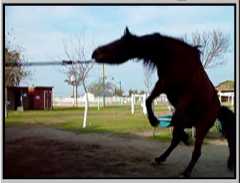Safety When Tying
|
Pulling against a dynamic tie
|
|
What do you do when you have a horse that has panic attacks at the tie pole?
Even if you use good tying practices (see Safe Knots for Tying Horses) you can still have a horse that will suddenly rear back and then fight the end of the rope. Some horses may sit down against the rope. Others may throw their heads and roll over. Either behavior is dangerous, and can cause serious injuries to the horses themselves and people nearby. Our objective is to keep the horse focused so he won't overreact and pull back on the rope. Clicker Training is a good technique for accomplishing this objective. But regardless of the training approach you choose, there is that period of time when the horse may panic and head full steam in reverse before he becomes adequately invested in your focusing technique. During this more risky period we advise a safer method of tying than a traditional tie line.
The most dangerous horse at the tie pole is the one who suddenly bolts backwards, then when he hits the end of the tie line he goes into a second stage panic wildly throwing his head, sitting down and/or rolling over. Some horses have sat down, broken the tie line, then flipped over backwards breaking saddles and sometimes their backs and necks in the process. Even when tied at the proper height, a static line can be dangerous with these types of horses. The most practical solution is to use a dynamic line. This is a line that has some stretch to it. When the horse rears backwards he isn't confronted with the sudden jerk at the end of the line. The dynamic tie line increases tension as the horse backs up until that tension is so great that the horse has to come forward to find relief. While the horse can still pull back pretty hard on the line, he generally can't get to that point where he can sit down against it since it is dynamically pulling him back toward the tie pole. We managed to catch a video of a horse suffering a panic attack at a tie pole who was attached to a dynamic line. If you study the video you will see that although she tried, the horse was unable to sit down against the line, she was drawn back to the tie pole and the tie line released pressure in time for her to be repositioned safely back where she belonged and where she stood for some time after the video clip ended. (Click on the image above to view the video. It is about 500kb long so it may take a minute or so to download.) There are several ways to make a dynamic tie line. Some people drop inner tubes around tie posts and fasten a regular tie rope to the inner tube. The inner tube provides the "dynamic stretch." Inner tubes are a bit bulky, some horses don't tolerate them very well and it's hard to engineer the correct tension and release. A dynamic tie can be fashioned using 5/8 in. dynamic climbing rope with the proper hardware or you can purchase a commercial dynamic tie line. We recommend a good quality commercially produced tie line since the line and hardware are compatible and are properly attached. Whether you make your own or purchase a tie line you need to consider some safety factors.
Eventually every horse tied using this system eventually settled down, explored the "feel" of the dynamic tie and stopped pulling. Finally, how people react when a horse panics at the tie pole is critical. If people get excited, start yelling and rushing around, it will only serve to fuel the horse's survival response (increased effort to pull away.) When we experience this kind of event everyone simply backs away from the horse and gives him room to work things out. The time to approach the horse is when he's finished pulling and is standing quietly at the pole. "The Leader" is available from better tack supply vendors and the company can be reached by calling 800.242.LEAD. Press "Back" to return to the page that brought you hereGo to Case Study SectionReturn to Training SectionReturn to Wild Horse MentorsReturn to KBR World of Wild Horses and BurrosGo To
|

